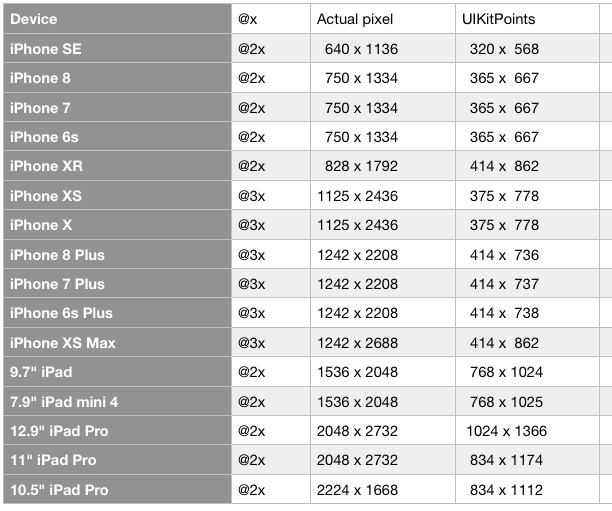
YvLy
Members-
Posts
10 -
Joined
-
Last visited
Everything posted by YvLy
-
Thanks again for all your help, v_kyr!!! . I need to go on vacation now. At least for a month. My head is spinning ....
-
????? ... that only applies to png, right?? With a pdf I only supply one ... or am I wrong?
-
v_kyr, again many thanks for your kind help! The way I understand it: XCode uses "Points" rather than "Pixel". When you design a vector-based fixed sized image, say 100x100, this approach is handy. Your image is always 100x100, on a retina screen it simply multiplied by 2x to 200x200 ... or 3x to 300x300. So far so good. But when I deal with photographic images, my starting point are REAL pixels. So if I want my photograph fullscreen on all devises, I have to deal with the actual pixel dimensions of all the IOS devices. At the moment they range from 640x1136 to 2048x2732 covering 16 IOS devices in seven groups, each group having different pixel-dimensions. So it seems to me that there is nearly always some rendering-up or rendering-down going on. So I guess my question is twofold: 1) What format should I use for the photographs in my assets well? Jpg's and accepting re-rendering of actual pixels or PDF and knowing that binary data is scaled? 2) What pixel dimension should I import into in my assets well? The highest (2048x2732) which then will be scaled down on all devices other than iPad Pro?
-
Same here, so far I always used jpg's. My problem is not the WORK in creating the 1x, 2x, 3x jpg's. Yes, I would use batch processing. My problem is rather that there are only THREE separate wells in XCode (1x, 2x, 3x) to cater for ALL 6 different screen sizes. So that means that some jpg's will be either rendered up or down. If I would use pdf, that problem would not occur ...
-
Well, yes ... You hit exactly the nail: It is indeed essentially about a "convenient way to build the image assets at 1x, 2x and 3x resolution without the pain of manually creating each file". But in my case I don't have pdfs containing vector images but pdfs containing high quality fullscreen photographs. I am still not quite sure which approach delivers the best results. Apple still recommend jpgs, even in XCode 10. But then there is of course the other issue: Even IF I go with jpgs, there are only 3 wells (1x,2x,3x) for all different screen resolutions of iPhones and iPads. What would you do to get the absolute best results, v_kyr? Thanks again!!!
-
0 Am I correct in saying: A PDF compression uses the same algorithm (DCTDecode) as jpg and the image is then drawn in the PDF contents stream. The difference is that a jpg compresses pixel, whereas pdf compresses binary data?? ... That is how I understood the articles.
-
I need to export jpg's for an IOS app and need different dimensions for different phones. I was planning to resize the jpg's but then several people suggested to use pdf instead. I am aware that you can scale pdf's when they contain vector and fonts ... but how does the scaling work with images?? Is the algorithm different? I always had the believe that a pdf simply CONTAINS a jpg and that the rendering algorithm are the same?
-
At the moment, you can only batch process to: AFPhoto, JPEG, PNG, TIFF and OpenEXR. There is no PDF option!! Considering that you have a lot of webdesigners as customers, wouldn't that be an important feature? Please add that ...

